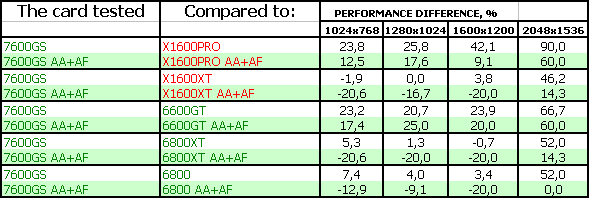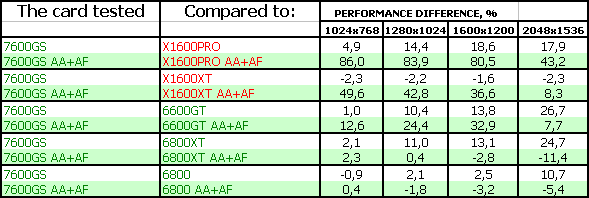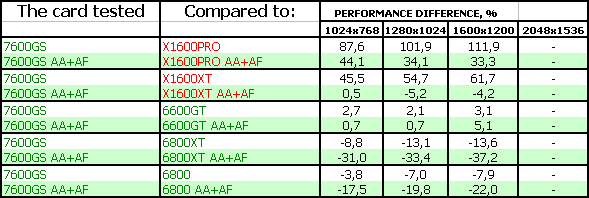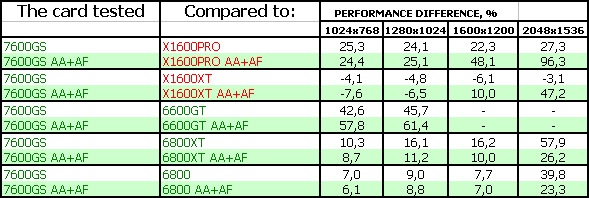 |
||
|
||
| ||
ContentsNot long ago we reviewed new products from NVIDIA, launched on March 9th. One of them was GeForce 7600 GT, intended to oppose RADEON X1600 XT. But prices for the latter have already dropped and so ATI has put the powerful RADEON X1800 GTO against the new accelerator from NVIDIA. We have some reasons to assume that there will be again no direct competition between them, as the real price for the X1800 GTO will be higher than for the 7600 GT. We'll see. In fact, a price for the X1600 XT is somewhere within $150-$170, for the X1600 PRO - $120-$130. The X1600 PRO is opposed by a direct competitor - GeForce 7600 GS, which will cost $129-$149. That is NVIDIA positions the 7600 GS as a competitor to the X1600 PRO. As the X1600 XT and the PRO cards differ only in frequencies, the 7600 GT and the GS cards differ only in these parameters. But ATI intends to drop prices again for its X1600 products in order to make the X1600 XT a direct competitor not to the 7600 GT, but to the GS card. And the X1600 PRO will compete with the GeForce 7300 GT. I don't quite understand how this tiny price segment ($80-$120) can hold the X1300, and the X1300 PRO, and the X1600 PRO. The main difficulty for testers of late has been complicated positioning of cards from competing companies, their prices varying much and differing from the recommended ones. That's why we'll compare GeForce 7600 GS not only with RADEON X1600 PRO, opposed by this product, but also with RADEON X1600 XT - its future competitor. It will be up to a user to decide, who will see real prices for these products and compare them. Of course, the 7600 GS has a simple design, so companies can vary prices in a wide range (the prime cost is low).
Video card
The PCB is a copy of the card from GeForce 6600 DDR2 (we already reviewed this product). This product comes with a passive heatsink by default, that is a noisy cooler is out of the question. But NVIDIA partners may equip this product with any cooling systems they like, so there may appear various modifications. Besides, this card also has a Low Profile reference design for SLIM PC cases, when half of chips is placed on the back side of the PCB. It's twice as low. The card has TV-Out with a unique jack. You will need a special bundled adapter to output video to a TV-set via S-Video or RCA. It also provides a component YPbPr output. You can read about the TV-Out in more detail here. The card is also equipped with DVI and VGA jacks. Two analog monitors with d-Sub (VGA) interfaces can be connected via a special DVI-to-d-Sub adapter. Maximum resolutions and frequencies:
I repeat that the reference design also provides for two DVI jacks (which will most likely be used more often). One of the jacks is DVI Dual Link.
Installation and DriversTestbed configuration:
VSync is disabled.
What concerns overclocking, we haven't tested such modes because of the top model in this series - GeForce 7600 GT. Test results: performance comparisonWe used the following test applications:
Game tests that heavily load vertex shaders, mixed pixel shaders 1.1 and 2.0, active multitexturing.FarCry, Research
The 7600 GS easily outperforms its main competitor X1600 PRO in these tests. But it's still slightly outperformed by the X1600 XT. You understand that if a price for the 7600 GS is closer to the X1600 PRO, the conclusion will be obvious :)
Game tests that heavily load vertex shaders, pixel shaders 2.0, active multitexturing.F.E.A.R.
On the face of it, it resembles the previous situation. But we should take into account that such cards offer a bad gameplay level in this game with AA+AF, so we should analyze modes without additional load, where the 7600 GS nearly catches up with the X1600 XT, heavily outperforming the Pro modification. That's why success of the new card from NVIDIA is obvious.
Splinter Cell Chaos Theory
It's again a similar situation. The 7600 GS fairs in between the X1600 PRO and the X1600 XT.
Call Of Duty 2 DEMO
The new cards take the lead in their category here. Half-Life2: ixbt01 demoTest results: Half-Life2, ixbt01 
Considering the gameplay and expediency of AA+AF modes, we can also certify success of the 7600 GS, where the card outperforms both competitors.
Game tests that heavily load pixel pipelines with texturing, active operations of the stencil buffer and shader unitsDOOM III High mode
Chronicles of Riddick, demo 44

Of course, it's all predestined in OpenGL games: NVIDIA products, especially in Middle-End, will always be leaders. It's high time that the Canadians should perfect their OGL. I still don't understand why they take no action? The problem has existed for three years already. A new driver could have been written from scratch for half a year or a year. So why hasn't it been done already? Why won't ATI hire programmers, experienced in this field? I just don't get it.
Synthetic tests that heavily load shader units3DMark05: MARKS
Purely shader tests tip the scale towards the Canadian cards. The 7600 GS faces the power of 12 shader processors of the X1600 and a high core frequency here, so it looks weaker than in the previous tests (by the way, it all illustrates a gap between 3DMark and real games). 3DMark06: MARKS Shader Model 2.0

Considering that this version of the popular benchmark has shifted a little from purely shader computations to more complex texturing, results of the 7600 GS have become a tad better, but the card still remains between its competitors. 3DMark06: MARKS Shader Model 3.0

It's a similar picture.
ConclusionsNVIDIA GeForce 7600 GS 256MB PCI-E is a very good product. That's the first time when cards with 12 shader and texture units come down to the $129 sector (remember the GeForce 6800, which differed from the 7600 card only in its 256-bit bus, and its price). It's inspiring. A simple design and a fanless cooler make this card a welcome component in barebone computers. Of course, I am again going to say that it will all be up to the price, as in case with the X1800 GTO. If the X1600 XT is cheaper, perhaps you'd better buy this one. If not, the evident choice in the $120-$130 segment is the 7600 GS. And don't forget that the X1600 XT operates nearly at the limit of its frequencies, while the 7600 GS can still be overclocked to 500 MHz (core) and even higher, coming close to the 7600 GT. So, in my opinion, the competition is won by the 7600 GS, that's quite fair. Yep, the notorious incompatibility of HDR and AA can poison some souls, but you will hardly enable AA in such cards. You should be grateful if your card copes with HDR and offers decent gameplay (games are getting increasingly complex). It's good news that such Hi-End attributes as HDR can already come down to a cheaper sector. I'll remind you one more time that GeForce 7600 GS cards from NVIDIA partners may vary (there are two modifications; besides, the cards may be equipped with fanned/fanless coolers and there may be two DVI jacks instead of DVI+VGA).
You can find more detailed comparisons of various video cards in our 3Digest.
Theoretical materials and reviews of video cards, which concern functional properties of the GPU ATI RADEON X1800 (R520)/X1600 (RV530)/X1300 (RV515) and NVIDIA GeForce 6800 (NV40/45)/7800 (G70)/6600 (NV43)Write a comment below. No registration needed!
|
Platform · Video · Multimedia · Mobile · Other || About us & Privacy policy · Twitter · Facebook Copyright © Byrds Research & Publishing, Ltd., 1997–2011. All rights reserved. | ||||||||||||||||||||||||||||||||||||||||||||||||||||